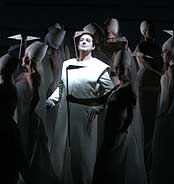Robert Wilson's production of Wagner's "Parsifal," unveiled by Los Angeles Opera on Saturday evening, is stunningly beautiful. That's the easy part.
Wilson's productions are always stunning, always miraculous exercises in elegant design and astonishing light. This one is a classic. It was first produced at the Hamburg Opera in 1991 and mounted at Houston Grand Opera the following year. On a glowing backdrop, Wilson creates the effect of a living Mark Rothko painting in light throughout Wagner's long, slow, musically complex, spiritual and — if you have the patience to let it work its magic on you — transfixing last opera. That light show alone is pretty much worth the steep price of admission to the Dorothy Chandler Pavilion.
But it isn't alone, and that's the hard — and really interesting — part.
Plácido Domingo has done the unthinkable. He sings Parsifal in this production. It was his choice; he runs the company. He certainly didn't need to do it. But apparently, there are few challenges of this order left in his career as tireless tenor, conductor, administrator and celebrity.
Sixtysomething Parsifal
For the ordinary mortal Wagnerian heroic tenor, simply singing Parsifal well into his 60s is a rare accomplishment, and Domingo was in stentorian voice Saturday. He, of course, is not going to sell anyone on impersonating a young "holy fool" anymore. Indeed, in a Wilsonian get-up of slicked-back hair and heavy white makeup, he looked very much the old fool.
And he seemed all the more fool to subject his aging joints to the heavily stylized Wilsonian postures and slow-motion movements. When he first walked onstage, wearing a stiff, white Japanese-inspired costume (toned down from Frida Parmeggiani's more flamboyant early '90s avant-garde original) and trying way too hard to restrict his natural Latin exuberance, the effect was almost risible. It might have been a "Saturday Night Live" skit, if "Saturday Night Live" knew anything about culture.
But you have to love Domingo's determination (he has signed up to sing in Wilson's production of the "Ring" in Paris this spring). In the end, uncomfortable as he clearly was, he came remarkably close to pulling this Parsifal off, especially given the way the physical challenges served to make his ageless vocal power and musical command of the role all the more thrilling.
This is Los Angeles Opera's first "Parsifal." The company, celebrating its 20th anniversary, is still relatively inexperienced in Wagner, having yet to work its way through even half the composer's canon. A "Ring" had once been promised for this year, but that won't happen until the end of the decade. A "Meistersinger" long ago fell victim to the budget.
Although not the longest (although some people think it feels like it is) or the most demanding of the Wagner operas for singers or orchestra, it is the deepest and the most difficult to pull off. Its mystical message is the enlightenment of Parsifal, who wanders into the mysterious dominion of the knights of the Holy Grail. They had been waiting for just such a naif to wrest the sanctified spear from the evil magician Klingsor, to heal the gaping wound of Amfortas, to do something about the spiritual crisis of the seductress Kundry and basically set things right again in the realm of the righteous.
Wilson throws out as much Wagnerian religiosity as he can. He focuses instead on the astonishing prescience of "Parsifal," a work that was at its premiere in 1882 the most harmonically advanced, architecturally fluid music ever written. It foretold, two decades before Einstein, not only the future of music but also science, as Gurnemanz, the Grail's guru, explains to an uncomprehending Parsifal that in this world, time and space are one.
Illumination
Wilson adds light to the equation (originally devised by Jennifer Tipton but here credited to A.J. Weissbard). His greatest contribution is the creation of illuminated images that don't so much illuminate the narrative as the music. The stage is all but bare. The swan that Parsifal kills is but a large wing in the background. The Grail is a large flattened torus, a thick neon-lighted bagel chip.
The singers don't physically emote, and for traditional opera performers that takes considerable restraint. Often, one felt all of them holding back unnaturally, as though they were still marking everything that stage director Nicola Panzer asked of them. Matti Salminen didn't quite manage to be still enough, but he sang Gurnemanz with wondrous warmth. Linda Watson had little of the wind-swept wonder of Dunja Vejzovic in Hamburg. Watson is a Wagnerian powerhouse, but I wonder why L.A. Opera didn't turn to Violetta Urmana, who was an impressively restrained Kundry in Walt Disney Concert Hall two years ago when Pierre Boulez conducted the opera's second act — she is the company's current Tosca.
A more vocally secure Klingsor than Hartmut Welker could surely have been found, but he was good and stiff, just as Wilson wanted him. Albert Dohmen's Amfortas was without any physical or vocal signs of the character's profound suffering, which proved a great relief. He excellently produced the sensation of pain by wandering aimlessly around the circular Grail and singing precisely.
Kent Nagano conducted. This is a radiant score, the most radiant music that Wagner wrote, which means some of the most radiant music ever written. The orchestra was a touch rangy at first, but gradually got into the shimmering spirit as Nagano marvelously emphasized the flowing character of the opera while also bringing out telling instrumental details. The chorus was mostly offstage, which is where it belonged in such an uncluttered production, and sounded wonderful.
At the end, fire erupted in the Grail's center; its hot yellow was one dimension. The cold white neon was another. The shimmering salmon backdrop, a third. The orchestra radiantly rising higher and higher approached the fourth dimension. This is not non-Euclidean geometry. It is the magic of theater. |

